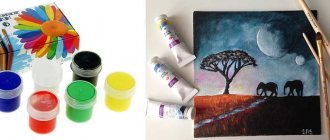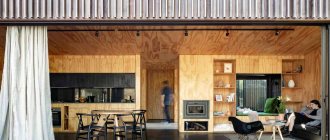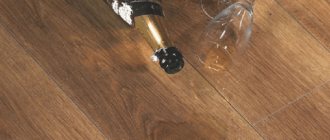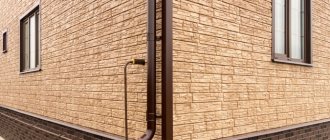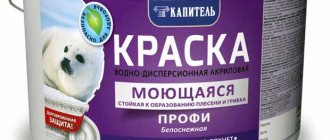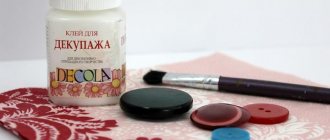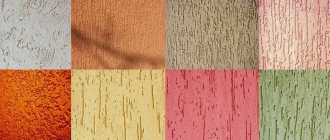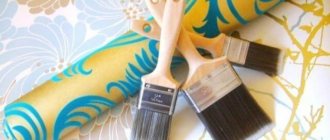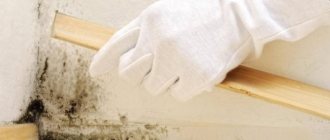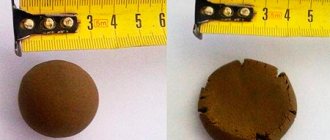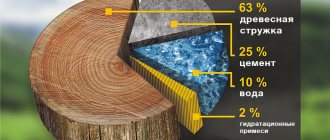Travertine is one of the representatives of natural stones, which is very popular and is actively used both for cladding the facades of houses and for interior decoration. Perhaps each of us is familiar with such a great structure as the Colosseum. It was not by chance that we reminded you of it, since it was built from travertine. But this is not the only structure for the construction of which antique travertine stone was used.
This stone has soft color shades and a porous structure; they give this stone those decorative qualities for which it is loved. The facade of the house, lined with travertine, looks great, at the same time strict and stylish, with a touch of antiquity. And if you are considering travertine as a finishing material for the facade of your own home, then you certainly have taste, and it is good. In this article we will talk about the features of travertine facades, their performance qualities and installation technology.
Travertine – a genius of stylistic flexibility
It will harmoniously fit into almost any concept, no matter in what style the architect conceives the stylistic solution of the house. There are examples of travertine cottages in the high-tech style, in the direction of “eco-design”, classics, Western European trends, Scandinavian traditions and others. Stone combines organically with natural wood, glass, concrete, iron and steel. He has an amazing ability to harmoniously mix styles, the main thing is competent design work.
Travertine has less choice of colors and shades than marble - this is a well-known fact. But it is impossible to say that there are few of them. A stone supplier with extensive experience can further expand the selection through special techniques. Thus, longitudinal and transverse cuts of slabs give different patterns. And different directions of grinding allow you to change the shade even within the same color.
Travertine cladding is a classic solution. Granite blocks are more traditional, marble blocks are more common.
The stone has a livelier “character” than stately granite, and more “homely” than high-status marble.
Methods for laying travertine on the floor
There are suture and seamless cladding methods. In large rooms, it is recommended to work using the first technology for two reasons:
1. Even if a specialist does the finishing, after 10-15-20 laid slabs there will be an inevitable displacement of the joint by at least 1 mm. The result is a distortion of the picture, which spoils the overall appearance of the room.
2. The material “breathes”, as a result of which, under the influence of changes in temperature and humidity in the room, a small, almost imperceptible shift of the slab occurs.
In both cases, it is the seams that compensate for micro-movements, and perfectly laid tiles remain perfect for a long time.
Laying work is best done at temperatures from +10°C to +40°C. Then the natural stone moves minimally and is fixed as firmly as possible on the surface.
The seamless method is suitable for small spaces. In this case, the slabs are laid with a minimum gap (0.5-1 mm), and the small dimensions of the room make the displacement almost imperceptible.
In order to hide the joints, another option is used - “Euro-laying”. According to standard technology, ready-made, finely polished tiles are installed on the floor, and with “Eurolaying” - a roughly processed, fairly large slab; finishing sanding is carried out after finishing is completed. The result of such installation of travertine is shown in the photo below.
“Euro-laying” is carried out as follows:
- The screed is being made.
- A roughly processed slab is laid on it, without adjusting the contacting elements in height.
- The resulting seams are filled with mastic, the color closest to the stone.
- The seams are polished with a single mirror, which makes them completely invisible.
Since the texture of the stone varies, it is better to lay tiles in a row not from one package and then move on to another, but to alternate them - take them from different ones. This way the floor pattern will be more interesting and beautiful.
This is an easier method compared to the standard ones - especially if you decide to do the finishing yourself. Its advantages also include the low cost of untreated slabs and more relaxed work, when you don’t have to worry every minute about the danger of scratching the product - you can remove any defect with subsequent finishing sanding.
It is best to start laying material from the middle of the room or from the main door. Don't forget to leave any scraps of tiles as you will need them to finish the edges of the floor. Be sure to constantly check the placement of elements with a level!
Properties of the stone
- Travertine is a soft rock. It lends itself easily to various types of processing. From it you can make amazingly beautiful stucco molding, bas-reliefs, pilasters, carved columns and other decorative elements.
- This stone is lighter than marble and granite. On the scale of a single plate, the difference is probably negligible. But if you calculate the load on the load-bearing capacity of the walls, it is felt.
- Environmental friendliness. Travertine, unlike artificial stone, does not emit harmful substances when the façade is heated by the sun, since it does not have polymer resins in its base. It is completely harmless to humans.
- Resistance to temperature changes. For travertine it is much higher than for marble. The stone easily tolerates Russian frosts, which are followed by thaws.
- Good heat and sound insulating properties. They are strengthened by such an installation method as a ventilated façade.
THERE IS A NUANCE!
“Travertine” and “liquid travertine” are different things. The first is a natural stone. The second is a type of decorative plaster with the addition of travertine chips. Accordingly, the listed properties apply only to whole breed.
Characteristics
Visually, travertine is quite diverse; The most common colors are white, beige and light gray. During processing, the stone is cut into slabs (large slabs), from which material of the required size is obtained: facing tiles, wall panels, countertops, steps for stairs. Interestingly, the surface pattern depends on whether the cut was transverse or longitudinal. When choosing travertine, you need to get acquainted with the following characteristics:
- Cutting type. It can be transverse or longitudinal, which affects the appearance of the texture.
- Surface protection. The cavities are filled (or left unfilled) with water repellents, for example, cement or various resins.
Source krasnodar.monolitfasad.ru
- Surface treatment. For processing, grinding and polishing are used. The surface can be matte, brushed (antique, aged), cut.
- Edge processing. The edge of the tile can be normal, chamfered, or tumbled (hewn).
- The size of the piece material, color and country of origin are indicated. This data helps you choose the most suitable travertine for the facade; the design depends on the style of the project and the tastes of the owners.
Source stroy-podskazka.ru
Weak points of travertine
The porous structure of the stone absorbs soot and dirt from car exhaust gases. If the house is located near a highway or noisy streets, the performing company will need to competently select a method for processing slabs with cavity filling. If the contractor copes with this task with an “A+”, there will be no problem of premature contamination of the façade. And care will not require significant investment in time.
Another concern associated with the porous structure is that water will enter the gaps, freeze, expand and gradually destroy the stone. But this same property helps moisture quickly evaporate, the walls do not freeze and moisture does not accumulate between the adhesive solution and the slabs. Thanks to it, the rooms in the house “breathe”, the microclimate in the rooms is not disturbed and the “greenhouse” effect is not created. Using the example of St. Peter's Cathedral in Rome, we see that the impact of precipitation only makes the stone mass lighter, giving a noble vintage appearance and a certain historical high cost. There is no noticeable destruction of the structure. Even soft travertine is stronger than the hardest artificial stone!
Appearance of travertine plaster
Travertine plaster for facades contains natural mineral components that provide a characteristic pattern that imitates natural stone.
There are 2 types of travertine facade plaster, differing in composition:
- Lime-based mixtures have high adhesive properties. Easily applied to bases of any structure.
- Mixtures based on silicate materials are characterized by a high degree of vapor permeability, which prevents the formation of fungi.
The finishing material creates a durable protective layer on the surface and is able to hide minor wall defects without forming cracks. Using various technologies for applying plaster, you can obtain original and varied patterns that imitate travertine stone. By tinting the mixture or further painting the surface, you can achieve the most accurate imitation of stone, which has a wide color palette.
Plaster has universal properties, which makes it possible to use it for finishing facades with any base. The environmentally friendly material is not afraid of sudden changes in temperature, dampness and high humidity. The durable coating is not subject to cracks or chips throughout its entire service life.
How best to install a travertine façade
Two methods of laying slabs are suitable for this stone - seamless and with seams.
- Seamless. The slabs are placed joint-to-joint, creating the impression of a monolithic stone wall, which is important for houses of modern styles. The disadvantage of this method is the high rigidity of the structure. If the building has not yet shrunk, it is better to prefer the classic method.
- Suture. Joints of 2-3 mm will prevent the tiles from peeling off when the cottage deforms. They can be painted to match the stone or contrast it.
In terms of installation technology, two options are suitable.
- Wet facade. An extremely simple method is when travertine slabs are fixed to a leveled base with an adhesive composition. The solution fills the voids between the wall and the stone, so the fasteners are strong. But it is still more often used for small-sized tiles due to their weight.
- Ventilated facade. It differs fundamentally from the previous version in that it requires the installation of a metal sheathing. The stone is fixed to it, leaving an air gap between it and the wall.
Which method should I choose? The first option is more often used for residential buildings; it is simple, fast and relatively inexpensive. The second is common for cladding administrative and office buildings, commercial premises, and high-rise buildings. Requires certain qualifications from installers and is more expensive. But it allows you to perform high-quality noise and sound insulation along with finishing.
Shell rock
Shell rock, due to its low density and loose structure, is best secured using special adhesives or concrete compounds. It is porous and absorbs wet compounds well, thereby improving adhesion and adhesion.
Natural shell rock is one of the hits of modern construction. It has long been given the status of the most objective alternative compared to other natural materials suitable as supports for creating load-bearing and non-load-bearing walls. In addition, it makes an almost ideal cladding option.
Despite its many advantages, it is notable for its low price. But most often, decorative shell rock is chosen because of its decorative effect.
Shell rock is produced in several versions, which allows us to distinguish three brands:
- M35, shell rock of very high density;
- M25, suitable for construction of 1-2 floors;
- M15, ideal material for fences and partitions.
When creating structures from shell rock, it is not necessary to make a standard foundation. Since the weight of shell rock is very small, its pressure is minimal.
The stone is very easy to process. If you need to decorate the façade with marble, not only slabs, but also solid blocks will do. It is in this form that it is convenient to deliver it to the site, and there it is cut into the necessary fragments.
To treat the tile surface, several techniques are used:
- Polishing finish;
- Bush hammering;
- Sawing technique.
The bathroom is the ideal room for travertine
Usually in the bathroom they choose a classic solution, most often tiles. However, if you want to highlight your interior a little and give it some character , you should consider using natural stone - travertine.
In the bathroom it will look great both on the wall and on the floor. It is quite resistant to various types of damage and, in addition, is associated with nature. Thus, its use provides high interior aesthetics .
Travertine washbasins can also be quite an unusual choice. They are extremely original and associated with luxury. Unfortunately, when choosing such equipment, you need to take into account that it is slightly more expensive than standard products. Some models even cost several tens of thousands of rubles.
Plaster application technique and material consumption
Advantages, composition and application of acrylic facade paints
The instructions for finishing work include five stages.
- Preparing the walls. This is a standard process prior to applying any finishing finish. They remove old coatings, remove loose layers of plaster, sweep away dust, and wash away dirt. Deep unevenness is filled with the base mixture and primed with quartz putty. Then the wall is puttied and again impregnated with primer.
- Preparation of working staff. The operation is carried out according to the instructions, and before work the solution is thoroughly mixed with a drill with a special nozzle. Lime strongly absorbs water, so you need to prevent the formation of lumps.
- Applying the base layer. It should be smooth, with a thickness of 0-1.0 mm (the parameter corresponds to the grain fraction of the filler). For work, use a trowel with rounded edges, made of stainless steel or plastic.
- Applying the top layer, glossing. The operation is performed after the base has completely dried (after 10-12 hours). The top layer is applied with a stainless steel spatula. It’s as if the wall is being stamped and not smoothed out. As a result, small growths form on the surface. After 15 minutes (when the solution dries slightly), use the same spatula to finely clean the uneven surfaces. The plane is gently smoothed and compacted so that it combines smooth and uneven areas.
- Finish and coloring. Decorative travertine plaster is covered with glazing compounds - two layers of varnish (roller and sponge), and then with moisture-resistant wax. Often wax is offered to be purchased as a kit. It is applied with a brush not to the entire area at once, but in sections of approximately 1 m2, after which the composition is rubbed with a sponge.
Usually white or beige Travertino is used in the work. The wall will look more impressive if you use any of the coloring methods:
- add pigment to the finished mixture;
- paint the dried plastered surface with colored azure and immediately wash it off with a damp sponge - this way an imitation of the depth of the relief is achieved;
- use tint varnishes to get soft transitions of tones;
- Apply watercolor, metallic or pearlescent wax.
Various external effects are created by applying decorative textured plaster with a stiff brush, trowel, or brush. Sometimes the solution is smeared with a glove, scratched, or rolled with a fur roller. The amount of consumption per 1 m2 of wall depends on the skill of the performer and the chosen technique. The instructions usually indicate the theoretical indicator of this parameter - from 1.5 to 2 kg of mixture per square meter with a coating thickness of no more than 2 mm. In fact, consumption varies within wider limits:
1. if application is carried out in wide strokes with large intervals (the effect of weathered stone), it takes up to 0.8-1.3 kg per m2;
2. if the solution is applied thickly and in a thicker layer, the pattern turns out to be more detailed and realistic, and the consumption increases to 3.4-3.5 kg/m2.
What else is worth knowing before choosing decorative travertine?
If you are going to use travertine in residential or commercial interiors , you must know how to handle it on a daily basis. Cleaning such a stone with water and a small addition of regular dishwashing detergent is not a problem. Do not clean travertine with harsh chemicals as this may cause unattractive discoloration. The colors can no longer be restored.
What color can travertine be? Gray is rare in his case, as is white. Most often it comes in warm shades - from cream to brown and yellow. It can have individual layers of orange or even red, creating a beautiful pattern on the tile.
In general, travertine has a light shade, but even tiles from the same batch may vary slightly, as well as the pattern. The structure of the stone is unique each time and produces remarkable visual effects depending on the direction in which the stone blocks are cut.

